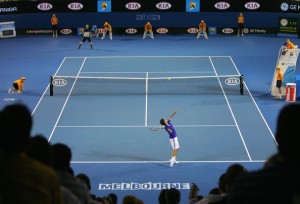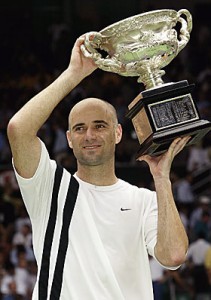Australian Open: Melbourne Heat, Near Misses, Dark Horses

The 2010 Australian Open begins on Monday, January 18th.
In tennis, the offseason between the outgoing year’s World Tour Finals (or the previous other names by which the year’s final ATP tournament was called) and the upcoming year’s first tournament is never too long.
It seems even shorter in the last few years with the advent of the Internet, which meant increased participation by fans; it went like a blitz this year as the decade came to a close. Pages worth of analysis were written, and tons of best and worst lists were formed, discussed, and argued upon.
In no time, Christmas and New Year’s Eve passed by…and suddenly Nikolay Davydenko had defeated Roger Federer and Rafael Nadal on back-to-back days, Robin Soderling got the 13th time luck against Federer (albeit in an exhibition match), Justine Henin and Kim Clijsters played a nerve-wracking thriller that was absent almost all of the last year in the WTA circuit, and—lo!—the draws of the year’s (rather, decade’s) first major have been released.
Australia, the Land Down Under, may be thinly populated, but it is probably the most dominant country in sports. Be it cricket, rugby, hockey, or football, they can teach the world a thing or two in each sport. In tennis, they boast of an unparalleled legacy. With legends like Rod Laver, John Newcombe, Ken Rosewall, and Roy Emerson, to name a few, they have fielded some of the finest tennis players ever to grace the game.
But despite this fine sporting history, their native Grand Slam tournament took time to establish itself. The Australian Open was constantly in a state of flux after the Aussie legends faded down the scene.
Previously held in late December, the Oz Open always struggled to attract big names who would usually rather spend their new year with the family than trade ground strokes after a tiring year. In fact, the Masters Cup was a bigger event than the Open, which was held in the attractive Madison Square Garden in the world’s commercial capital just after the new year.
If the timing was odd, its location was not great either. The grass courts at the Kooyong Stadium looked more like open-air practice stadiums than tennis’ battle grounds. It was no wonder, then, that legends like Bjorn Borg, John McEnroe, and Jimmy Connors filled their pockets with exhibitions rather than boost up their Slam record.
It was during the mid-’80s that the event finally started to gain recognition. A more acceptable timing in January, the change in venue to the brand new Melbourne Park with the prestigious Rod Laver’s Arena as the Center Court, and the interest shown by the emerging stars—Stefan Edberg, Ivan Lendl, Mats Wilander, and later Andre Agassi—enhanced its reputation as a tennis major, and, two decades later, it is no longer considered inferior to the other majors.

Andre Agassi was a four-time winner of the Australian Open
In fact, these changes transformed it from the “ignored Slam” to the Slam offering the most spectacular tennis. All players are usually fit, fresh, and motivated at the start of the year, the medium-paced surface allows players of all skill sets to thrive, the inhuman heat conditions offer more exciting drama, and the enthusiastic Melbourne crowd is a spectacle in itself.
No wonder, then, that this Slam witnesses dark horses almost every year. Schuettler, Johansson, Clement, Safin (2004), Baghdatis, Gonzalez, Tsonga, Verdasco; eight dark horses managed to tear apart the draw in the last 10 years, creating major upsets along the way and keeping the viewers interested with its unpredictability.
Unpredictability is not the only predictable factor in Melbourne. The quality of contests is mind blowing, reaching an unimaginable level in 2009. Starting from Hewitt-Gonzalez in the first round, which stretched till 4 in the morning, it housed thrillers like Gonazlez-Gasquet, Verdasco-Murray, and arguably the year’s best match in Nadal-Verdasco, finally ending high on emotions with the Federer-Nadal final.
And with the current draw as open as any in the recent history, the decade’s first major promises to offer even more than it did last year. Picking a favorite will be a tough job, as every one of the top six players has an equally good chance to be the last man standing.
The draws are released, and the first look is very promising both on the men’s and women’s side. It is time to scratch our heads to decipher deep into the draws and find out the potential mouth-watering contests. JA Allen and Marianne Bevis have already started their share of the work and will present a detailed description of the men’s and women’s side of the draws.
Meanwhile, we wait agonizingly as the clock slowly ticks over to Monday the 18th.









